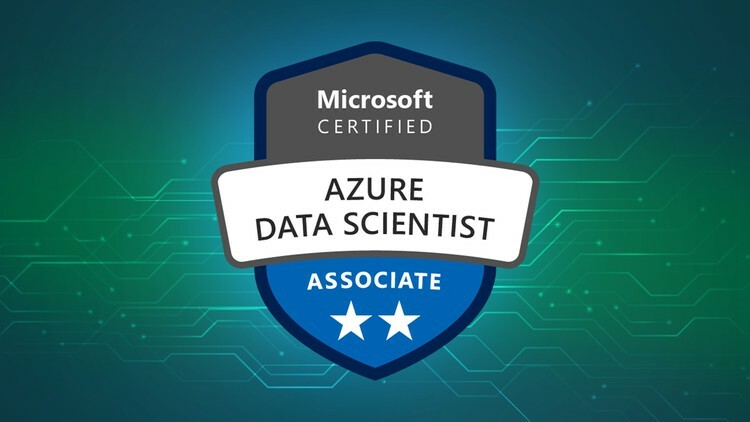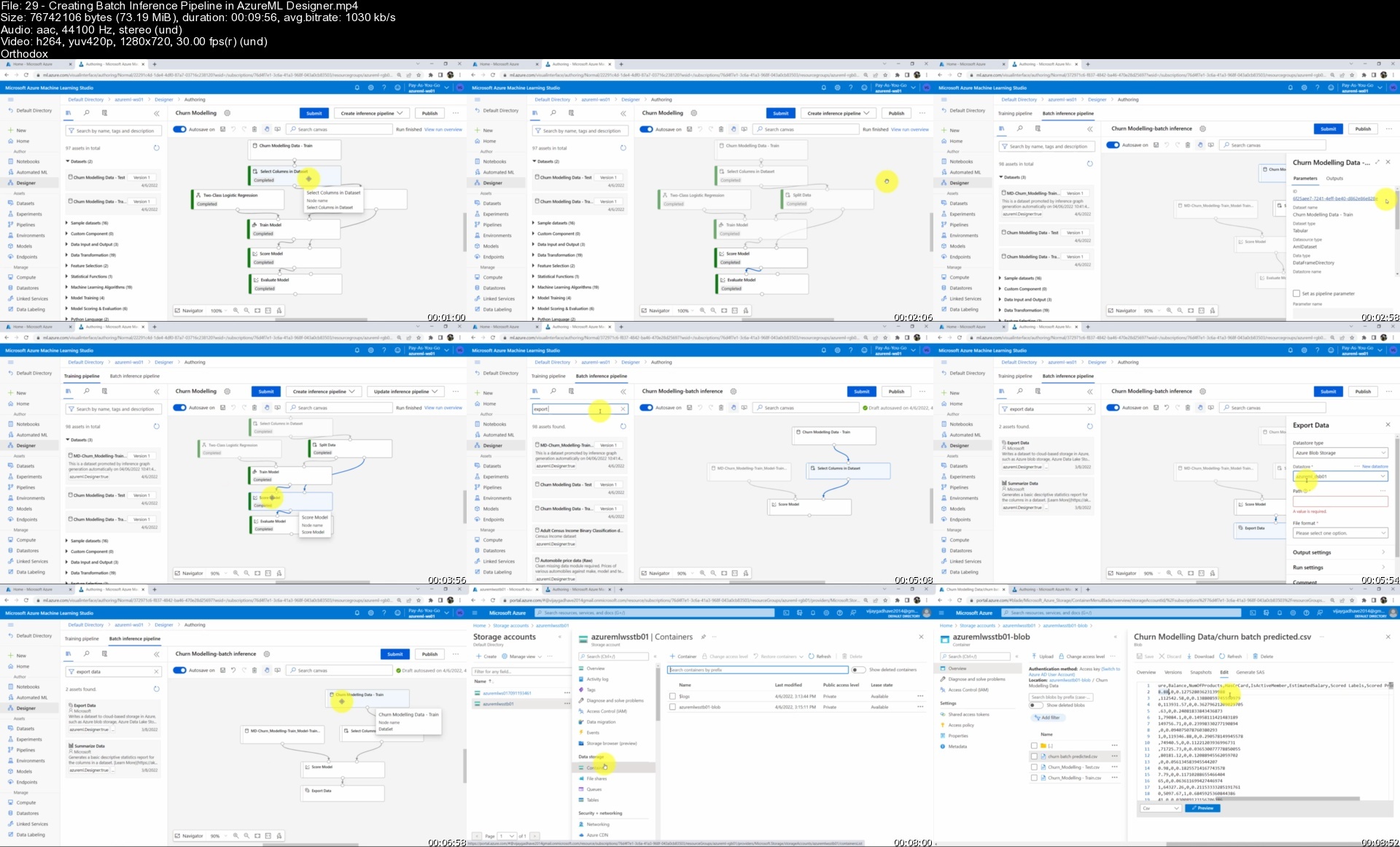
Dp-100: Azure Machine Learning & Data Science Exam Prep 2022
Last updated 10/2022
MP4 | Video: h264, 1280x720 | Audio: AAC, 44.1 KHz
Language: English | Size: 8.49 GB | Duration: 21h 27m
Azure Machine Learning, AzureML, Exam DP-100: Designing and Implementing a Data Science Solution, 4 End-to-End Projects
What you'll learn
Prepare for DP-100 Exam
Getting Started with Azure ML
Setting up Azure Machine Learning Workspace
Running Experiments and Training Models
Deploying the Models
AzureML Designer: Data Preprocessing
Regression Using AzureML Designer
Classification Using AzureML Designer
AzureML SDK: Setting up Azure ML Workspace
AzureML SDK: Running Experiments and Training Models
Use Automated ML to Create Optimal Models
Tune hyperparameters with Azure Machine Learning
Use model explainers to interpret models
Requirements
Basic Understanding of Machine Learning
A Free or Paid Subscription to Microsoft Azure
Description
Machine Learning and Data Science are one of the hottest tech fields now a days ! There are a lot of opportunities in these fields. Data Science and Machine Learning has applications in almost every field, like transportation, Finance, Banking, Healthcare, Defense, Entertainment, etc.Most of the professionals and students learn Data Science and Machine Learning but specifically they are facing difficulties while working on cloud environment. To solve this problem I have created this course, DP-100. It will help you to apply your data skills in Azure Cloud smoothly.This course will help you to pass the "Exam DP-100: Designing and Implementing a Data Science Solution on Azure". In this course you will understand what to expect on the exam and it includes all the topics that are require to pass the DP-100 Exam.Below are the skills measured in DP-100 Exam,1) Manage Azure resources for machine learning (25-30%)Create an Azure Machine Learning workspaceManage data in an Azure Machine Learning workspaceManage compute for experiments in Azure Machine LearningImplement security and access control in Azure Machine LearningSet up an Azure Machine Learning development environmentSet up an Azure Databricks workspace2) Run experiments and train models (20-25%)Create models by using the Azure Machine Learning designerRun model training scriptsGenerate metrics from an experiment runUse Automated Machine Learning to create optimal modelsTune hyperparameters with Azure Machine Learning3) Deploy and operationalize machine learning solutions (35-40%)Select compute for model deploymentDeploy a model as a serviceManage models in Azure Machine LearningCreate an Azure Machine Learning pipeline for batch inferencingPublish an Azure Machine Learning designer pipeline as a web serviceImplement pipelines by using the Azure Machine Learning SDKApply ML Ops practices4) Implement responsible machine learning (5-10%)Use model explainers to interpret modelsDescribe fairness considerations for modelsDescribe privacy considerations for dataSo what are you waiting for, Enroll Now and understand Azure Machine Learining to advance your career and increase your knowledge!
Overview
Section 1: Getting Started with Azure ML
Lecture 1 Introduction to Azure Machine Learning
Lecture 2 Introduction to Azure Machine Learning Studio
Lecture 3 Azure ML Cheat Sheet
Lecture 4 DP-100 Exam Skills Measured (Exam Curriculum)
Lecture 5 Course Slides, Colab Notebooks and Datasets
Section 2: Microsoft Azure Fundamentals - Introduction
Lecture 6[OPTIONAL] Introduction to Microsoft Azure
Lecture 7[OPTIONAL] Introduction to Microsoft Azure Fundamentals
Lecture 8[OPTIONAL] Introduction to Cloud Computing
Lecture 9[OPTIONAL] Introduction to Azure Portal
Lecture 10[OPTIONAL] Introduction to Azure Marketplace
Lecture 11[OPTIONAL] Azure Free Account
Lecture 12 Creating Microsoft Azure Account
Section 3: Setting up Azure Machine Learning Workspace
Lecture 13 Azure ML: Architecture and Concepts
Lecture 14 Creating AzureML Workspace
Lecture 15 Workspace Overview
Lecture 16 AzureML Studio Overview
Lecture 17 Introduction to Azure ML Datasets and Datastores
Lecture 18 Creating a Datastore
Lecture 19 Creating a Dataset
Lecture 20 Exploring AzureML Dataset
Lecture 21 Introduction to Azure ML Compute Resources
Lecture 22 Creating Compute Instance and Compute Cluster
Lecture 23 Deleting the Resources
Section 4: Running Experiments and Training Models
Lecture 24 Azure ML Pipeline
Lecture 25 Creating New Pipeline using AzureML Designer
Lecture 26 Submitting the Designer Pipeline Run
Section 5: Deploying the Models
Lecture 27 Creating Real-Time Inference Pipeline
Lecture 28 Deploying Real-Time Endpoint in AzureML Designer
Lecture 29 Creating Batch Inference Pipeline in AzureML Designer
Lecture 30 Running Batch Inference Pipeline in AzureML Designer
Lecture 31 Deleting the Resources
Section 6: AzureML Designer: Data Preprocessing
Lecture 32 Setting up Workspace and Compute Resources
Lecture 33 Sample Datasets
Lecture 34 Select Columns in Dataset
Lecture 35 Importing External Dataset From Web URL
Lecture 36 Edit Metadata - Column Names
Lecture 37 Edit Metadata - Feature Type and Data Type
Lecture 38 Creating Storage Account, Datastore and Datasets
Lecture 39 Adding Columns From One Dataset to Another One
Lecture 40 Adding Rows From One Dataset to Another One
Lecture 41 Clean Missing Data Module
Lecture 42 Splitting the Dataset
Lecture 43 Normalizing Dataset
Lecture 44 Exporting Data to Blob Storage
Lecture 45 Deleting the Resources
Section 7: Project 1: Regression Using AzureML Designer
Lecture 46 Creating Workspace, Compute Resources, Storage Account, Datastore and Dataset
Lecture 47 Business Problem
Lecture 48 Analyzing the Dataset
Lecture 49 Data Preprocessing
Lecture 50 Training ML Model with Linear Regression (Online Gradient Descent)
Lecture 51 Evaluating the Results
Lecture 52 Training ML Model with Linear Regression (Ordinary least squares)
Lecture 53 Training ML Model with Boosted Decision Tree and Decision Forest Regression
Lecture 54 Finalizing the ML Model
Lecture 55 Creating and Deploying Real-Time Inference Pipeline
Lecture 56 Creating and Deploying Batch Inference Pipeline
Lecture 57 Deleting the Resources
Section 8: Project 2: Classification Using AzureML Designer
Lecture 58 Creating Workspace, Compute Resources, Storage Account, Datastore and Dataset
Lecture 59 Business Problem
Lecture 60 Analyzing the Dataset
Lecture 61 Data Preprocessing
Lecture 62 Training ML Model with Two-Class Logistic Regression
Lecture 63 Training ML Model with Two-Class SVM
Lecture 64 Training ML Model with Two-Class Boosted Decision Tree & Decision Forest
Lecture 65 Finalizing the ML Model
Lecture 66 Creating and Deploying Batch Inference Pipeline
Section 9: AzureML SDK: Setting up Azure ML Workspace
Lecture 67 AzureML SDK Introduction
Lecture 68 Creating Workspace using AzureMl SDK
Lecture 69 Creating a Datastore using AzureMl SDK
Lecture 70 Creating a Dataset using AzureMl SDK
Lecture 71 Accessing the Workspace, Datastore and Dataset with AzureML SDK
Lecture 72 AzureML Dataset and Pandas Dataset Conversion
Lecture 73 Uploading Local Datasets to Storage Account
Section 10: AzureML SDK: Running Experiments and Training Models
Lecture 74 Running Sample Experiment in AzureML Environment
Lecture 75 Logging Values to Experiment in AzureML Environment
Lecture 76 Introduction to Azure ML Environment
Lecture 77 Running Script in AzureML Environment Part 1
Lecture 78 Running Script in AzureML Environment Part 2
Lecture 79 Uploading the output file to Existing run in AzureML Environment
Lecture 80 Logistic Regression in Local Environment Part 1
Lecture 81 Logistic Regression in Local Environment Part 2
Lecture 82 Creating Python Script - Logistic Regression
Lecture 83 Running Python Script for Logistic Regression in AzureML Environment
Lecture 84 log_confusion_matrix Method
Lecture 85 Provisioning Compute Cluster in AzureML SDK
Lecture 86 Automate Model Training - Introduction
Lecture 87 Automate Model Training - Pipeline Run Part 1
Lecture 88 Automate Model Training - Pipeline Run Part 2
Lecture 89 Automate Model Training -Data Processing Script
Lecture 90 Automate Model Training - Model Training Script
Lecture 91 Automate Model Training - Running the Pipeline
Section 11: Use Automated ML to Create Optimal Models
Lecture 92 Introduction to Automated ML
Lecture 93 Automated ML in Azure Machine Learning studio
Lecture 94 Automated ML in Azure Machine Learning SDK
Section 12: Tune hyperparameters with Azure Machine Learning
Lecture 95 What Hyperparameter Tuning Is?
Lecture 96 Define the Hyperparameters Search Space
Lecture 97 Sampling the Hyperparameter Space
Lecture 98 Specify Early Termination Policy
Lecture 99 Configuring the Hyperdrive Run - Part 1
Lecture 100 Configuring the Hyperdrive Run - Part 2
Lecture 101 Creating the Hyperdrive Training Script
Lecture 102 Getting the Best Model and Hyperparameters
Section 13: Use Model Explainers to Interpret Models
Lecture 103 Interpretability Techniques in Azure
Lecture 104 Model Explainer on Local Machine
Lecture 105 Model Explainer in AzureML Part 1
Lecture 106 Model Explainer in AzureML Part 2
Section 14: Model Registration and Deployment Using Azureml SDK
Lecture 107 Introduction to Serialization and Deserialization
Lecture 108 Serialization Using Joblib
Lecture 109 Deserialization Using Joblib
Lecture 110 Handling Dummy Variables in Production
Lecture 111 Train ML Model for Webservice Deployment
Lecture 112 Register the Model Using Run ID pkl File
Lecture 113 Register the Model Using Local pkl File
Lecture 114 Provision AKS Production Cluster
Lecture 115 Revising the Steps Learned
Lecture 116 Project 3: Step 1 (Creating and Accessing the Workspace)
Lecture 117 Project 3: Step 2 (Train and Serialize ML Model)
Lecture 118 Project 3: Step 3 (Register the Model to Workspace)
Lecture 119 Project 3: Step 4 (Register an Environment)
Lecture 120 Project 3: Step 5 (Create AKS Cluster)
Lecture 121 Project 3: Step 6 (Inference and Deployment Configuration)
Lecture 122 Project 3: Step 7 (Creating the Entry Script)
Lecture 123 Project 3: Step 8 (Creating an Endpoint)
Lecture 124 Project 3: Step 9 (Testing the Web Service)
Lecture 125 Project 4: Deploy Multiple Models as Webservice (Step 1)
Lecture 126 Project 4: Deploy Multiple Models as Webservice (Step 2)
Lecture 127 Project 4: Deploy Multiple Models as Webservice (Step 3)
Lecture 128 Project 4: Deploy Multiple Models as Webservice (Step 4)
Section 15: Azure Fundamentals: Virtual Machines
Lecture 129 Introduction to Azure Virtual Machines
Lecture 130 Creating Virtual Machine in Azure
Lecture 131 Connecting to Virtual Machine and Running Commands
Lecture 132 Key Concepts - Image, Size and Disks
Lecture 133 Commands executed in Tutorial
Lecture 134 Installing nginx on Azure Virtual Machine
Lecture 135 Commands executed in Tutorial
Lecture 136 Simplification of Software Installation on Azure Virtual Machine
Lecture 137 Availability Sets and Zones
Lecture 138 Virtual Machine Scale Sets
Lecture 139 Scaling and Load Balancing with VM Scale Sets
Lecture 140 Static IP, Monitoring, Dedicated Host and Reducing the Cost
Lecture 141 Designing Good Solutions with Azure VMs
Section 16: Azure Fundamentals: Managed Compute Services
Lecture 142 Introduction to Azure Managed Compute Services
Lecture 143 Introduction to IaaS, PaaS and SaaS
Lecture 144 Introduction to Azure App Service
Lecture 145 Creating First Web App using Azure App Service
Lecture 146 More about the Azure App Service
Lecture 147 Introduction to Containers
Lecture 148 Introduction to Azure Container Instances
Lecture 149 Container Orchestration - AKS and Service Fabric
Lecture 150 Introduction to Azure Serverless
Lecture 151 Azure Serverless Service - Azure Functions
Lecture 152 Logic Apps
Lecture 153 Azure Shared Responsibility Model
Lecture 154 Review - Azure Compute Services
Lecture 155 Deleting Recourse Groups
Section 17: Azure Fundamentals: Storage
Lecture 156 Introduction to Azure Storage
Lecture 157 Managed and Unmanaged Block Storage in Azure
Lecture 158 Azure Files
Lecture 159 Azure Blob Storage and Tiers
Section 18: Azure Fundamentals: Databases
Lecture 160 Introduction to Database
Lecture 161 Snapshots, Transaction Logs, Standby Database
Lecture 162 RTO and RPO
Lecture 163 Data Consistency
Lecture 164 How to Select a Database ?
Lecture 165 Introduction to Relational Database
Lecture 166 Relational Database-OLTP
Lecture 167 Creating MySQL Server in Azure
Lecture 168 Code executed in next tutorial
Lecture 169 Exploring MySQL Server in Azure
Lecture 170 Relational Database - OLAP (Online Analytics Processing)
Lecture 171 Azure NoSQL Database: Azure Cosmos DB
Lecture 172 Exploring Azure NoSQL Database: Azure Cosmos DB
Lecture 173 Azure In-Memory Database: Azure Cache for Redis
Lecture 174 Review: Databases
Lecture 175 Databases: Scenarios
Lecture 176 Deleting Database Recourse Groups
Anyone who wants to learn Azure Machine Learning,Students and Professionals Who Wants to Pass DP-100 Exam
Homepage
https://anonymz.com/?https://www.udemy.com/course/dp-100-azure-machine-learning-data-science-for-beginners/

https://nitroflare.com/view/4660845F8EA7FB8/DP100_Azure_Machine_Learning_%26_Data_Science_Exam_Prep_2022.part1.rar https://nitroflare.com/view/324F3137FF0B032/DP100_Azure_Machine_Learning_%26_Data_Science_Exam_Prep_2022.part2.rar
https://k2s.cc/file/0e721cf6644cb/DP100_Azure_Machine_Learning___Data_Science_Exam_Prep_2022.part1.rar https://k2s.cc/file/913978b93461f/DP100_Azure_Machine_Learning___Data_Science_Exam_Prep_2022.part2.rar
https://rapidgator.net/file/6d3a02a37f61f86e2b4efc6a0259228a/DP100_Azure_Machine_Learning_&_Data_Science_Exam_Prep_2022.part1.rar.html https://rapidgator.net/file/4a946003b0786884962666fda146025c/DP100_Azure_Machine_Learning_&_Data_Science_Exam_Prep_2022.part2.rar.html

